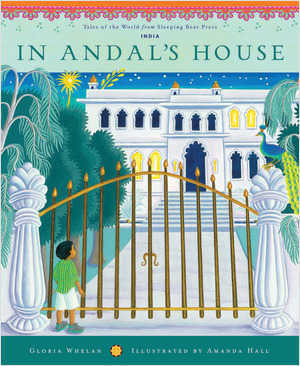Contribute
| Book Review - In Andal's House |
Reviewed by Tara Menon
09/02/2013
Review of In Andal’s House -by Tara Menon Kumar, the Dalit protagonist, whose father is a postal worker, has been invited to the house of his classmate, Andal, to see the Diwali fireworks. Andal is a Brahmin who lives in a palatial home. Over a meal of dal and mango pickle, Kumar’s incredulous mother asks him if he’s sure he’s been invited. Her son is confident he’s invited and says that it’s just for the fireworks. After dinner, he lights clay oil lamps in front of his home. When he sees the pretty rangoli his sister, Anika, made he feels guilty. His sister would like to attend the National Institute of Design, but she works in a textile factory and saves her money so her brother can go to university someday. Whelan’s Kumar is an admirable protagonist even though he is not heroic. He studies hard, hoping to get a scholarship in order to keep Anika’s savings for her own higher education or for her dowry. He is the best student in his class and he believes that’s why Andal has invited him to his fireworks party. He speaks three languages: English, Hindi, and Gujarati. Kumar wants to make cars at Tata Motors when he grows up or, better yet, become a computer programmer or a famous cricket player. The boy has a streak of independence that makes him rebel when his mother wants to send his sister to accompany him to Andal’s house. “How can I turn up in front of my friends like a little dog tied to my sister’s leash?†he asks wittily. However, partly in jest and partly to show his sister he cares for her, Kumar touches her feet “for all women carried the holiness of the feminine goddess within themselves.†Here Whelan strains a bit just to show the positive traditional attitude toward girls and women, but, on the whole, in In Andal’s House she’s more successful in balancing the good and bad of Indian life than in her other books set in India. The child’s point of view comes across well in the third person narrative voice Whelan adapts. “The streets were crowded with holiday shoppers, all in a good mood. You could bump into someone and they only laughed and wished you well. The women in their saris were like brightly colored butterflies.†Amanda Hall, the award-winning illustrator, conspires to present Kumar’s viewpoint. The white home looks overwhelmingly grand and forbidden to the Dalit boy as he views it behind the fancy pillared gate. In fact, the residence has an almost fairy tale quality to its appearance. There is only one villain in the story – Andal’s grandmother. There again, Hall shows us Kumar’s point of view; the old woman appears frightening in her hostility. He slants stiffly backward in shock as he listens to her prejudiced words. Her cruelty stems from her belief that Dalits would pollute the residence of a Brahmin family. She makes the servant show Kumar out of the house. His expulsion is all the more poignant because he has glimpsed Andal and two other classmates in an interior room. If the grandmother had come down a few minutes later, the story would have had a different outcome, one in which her grandson could have stuck up for his friend. What adds to the sadness of the climax is that the jubilant boys are unaware Kumar has been denied the opportunity to celebrate with them. Though the picture that illustrates the scene is superb, Hall could have contrasted the clothing worn by the privileged children and the Dalit boy as another telling detail about the differences in their lifestyles. Kumar accepts his rejection from the house stoically. He merely laments to his grandfather, “Nothing has changed.†And, “It is just as bad for us outcastes as it always was.†To give heart to his grandson, the grandfather delivers a lovely enlightening intimate speech, explaining how the lot of the Dalits has improved. What is missing in the narrative is an exuberance of feeling at the beginning (it is Diwali after all) and the plumbing of emotions in general. Kumar’s sadness is shown with a couple of matter-of-fact statements and a beautiful simile. “As Kumar walked home, fireworks exploded in brilliant patterns of stars and fountains and pinwheels. He had been looking forward all week to watching them with Andal and the other boys. Now they were spoiled for him. He watched them fall to the ground like brightly colored tears.†Hall, however, gives us a full length close-up of half of Kumar’s face with the fireworks reflected in his sad eye. In spite of the sparseness of emotion and thinness of plot, Whelan has spun a touching story, the kind that brings tears to the eyes and a lump to the throat. At the same time, she gives children hope and makes them understand society can change for the better. Pared down to the essentials, In Andal’s House is about exclusion, something children have all experienced in one way or another. The story may make children, even in America, more inclusive when invitation lists are drawn up. In the end, fetes are for everyone and celebrations of festivals could serve as great equalizers.In Andal’s House
by Gloria Whelan
You may also access this article through our web-site http://www.lokvani.com/
